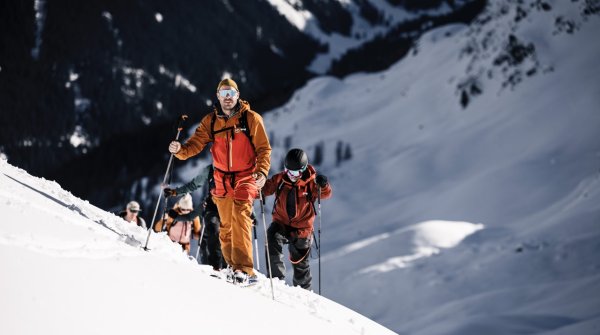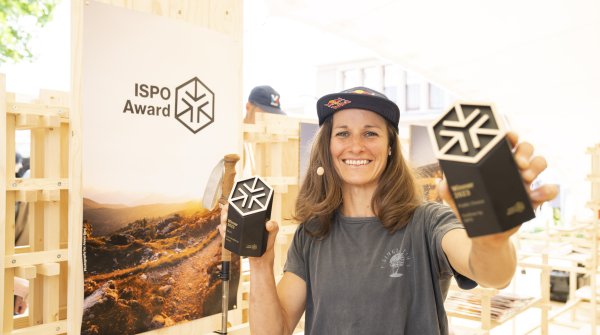
ISPO Munich 2018 is the place where winter sports brands, too, present themselves. This year, many of these manufacturers are no longer just offering skiing equipment, they’re also diversifying their portfolios. Companies like Salomon and Rossignol are evolving into complete outfitters by buying segments or expanding their own product lineups. Pure ski companies then become outdoor companies, which also cover segments such as biking and trail running. But is there really a general trend here? In any case, a snowy winter in 2017/2018 has given the industry a good boost – and made for good sales figures.
We asked leading winter sports brands: What do your middle and long-term strategies for the future look like? Eight experts give exciting insights:
- Philipp Giselbrecht, Product and Marketing Chief at Kästle
- Thomas Delago, founder of Nitro Snowboards
- Xavier Le Guen, Vice President of Salomon Winter Sports Equipment
- Thierry Kunz, CMO of Nidecker
- Reto Aeschenbacher, Brand Manager at Scott Sports
- Josef Holub, founder and co-owner of goodboards
- Andrea Wigger and Vincent Bardy from Marketing at Movement
- Florian Estermeier, Director of Sales at Rossignol Germany
Rossignol Ski Germany is part of the French Rossignol Group. Ten employees work in Munich’s Germany office, including Florian Estermeier as Director of German Sales.
Florian Estermeier: “Rossignol is also focusing on this strategy, and is currently positioning itself more broadly. In the future, we’re going to serve an all-year segment. Our bikes and paddle rackets will be in the forefront here, but also textiles for winter and summer in the Sport and Urban sectors.”
Thomas Delago founded the snowboard brand Nitro together with Sepp Ardelt in Seattle in 1990. Nitro AG is now headquartered in Switzerland.
Thomas Delago: “Many winter sports brands are attempting to position themselves ‘more broadly’ and compensate for the imbalance of a seasonal business with summer or year-round products. Sometimes this succeeds, but it also has its pitfalls. It’s about not losing your brand identity and expertise in all of the stabilization and growth strategies. All too often, when announcements are made, when acquired brands or business units are sold off again, you hear the comment ‘concentrate on the core competencies.’ The consolidation of the snowboarding industry and an increasing quality awareness among customers primarily favors brands focused on qualitative, not quantitative growth. Authenticity and quality are the top priorities. That’s where our focus is.”
Snowsports at ISPO Munich 2018 in pictures
Movement is a young, Swiss company that is constantly coming up with innovations in the tour ski and freeride ski sectors. The freeski sector is their core business. The company employs roughly 20 people. Andrea Wigger and Vincent Bardy are part of the Marketing department.
Andrea Wigger and Vincent Bardy: “Our strategies are: diversification in the outdoor sector, innovation, as well as differentiation in service and quality (production and delivery). To do this, we’re seeking proximity to our end consumers and using tools such as Touring Tracks or our Movement Ski Tests on Tour, as well as various events.”
Scott Sports is a Swiss sporting goods manufacturer with American roots. Important business areas are bicycles, winter sports, motor sports, and running. Founded in the year 1958, the company currently employs 270 workers. Reto Aeschenbacher is the Brand Manager at Scott Sports.
Reto Aeschenbacher: “We’re already part of a larger group that includes sports across all four seasons. In the winter business, our focus is therefore on concentrating our product development, our marketing, and our distribution on the segments within the industry that are positive. We’ve also acquired other specialized brands that aren’t exclusively dependent on the winter.”
Xavier Le Guen has been Vice President of Salomon Winter Sports Equipment since September 2017. Salomon has its headquarters with 400 employees in Annecy, France, is a market leader in the winter sports equipment sector, and is part of the Amer Sports Group.
Xavier Le Guen: “For more than 25 years, it’s been Salomon’s strategy to be an outdoor brand 365 days a year. As the market leader in trail running, our footwear, apparel, and bags product ranges offer the brand a strong presence in the mountains as early as the summer. This strategy also makes it possible to reach a large number of consumers in their everyday lives, in the city or in the valley. The key for Salomon is establishing a strong connection to outdoor enthusiasts all year round. Of course, we are actively looking for new ways to play outdoors. We are untiringly asking ourselves how we can offer consumers and our retail partners added value 365 days a year. This happens through internal development, acquisition, or partnerships.”
Goodboards is a German board company headquartered on Lake Ammer, near Munich. The company was founded in 2010, produces exclusively in Europe, and has more than 50 employees. Josef Holub is the founder and co-owner of goodboards.
Josef Holub: “We specialize in products made of wood, we don’t want to be a full-range supplier. At first we only produced snowboards, and then we expanded our selection with wakeboards, kiteboards, and skis. In doing so, we use a similar technology, similar materials, and have two strong products for the winter and two for the summer.”
The Nidecker Group was founded in 1887 and includes Nidecker Snowboards / SUP, Yes Snowboards, Jones Snowboards, Now Bindings, and Flow Snowboards. In total, 50 employees work for Nidecker at the main headquarters in Switzerland and in the North American headquarters in Truckee, California. Thierry Kunz is CMO in Nidecker’s board and marketing chief for Nidecker and Flow. Kunz was a professional snowboarder in the early 1990s.
Thierry Kunz: “We are a group that creates, launches, or acquires brands. We concentrate primarily on snowboarding. In addition, we are still engaged in the SUP sector. But our goal as a family-owned company isn’t to grow just to make some shareholders happy. We attempt to get the best out of our products for our customers. That is important to us.”
Philipp Giselbrecht is responsible for all marketing and communications tasks, as well as product management, at Kästle. The Kästle brand was founded in 1924, and ranks among the oldest ski brands in the world. It’s headquartered in Hohenems, Austria and has 40 employees.
Philipp Giselbrecht: “Our focus is very clearly on the ski sector. In our in-house production, we also produce other sports equipment such as the sledding shells for the Austrian national team of artificial track luge athletes used at the Olympic Games. With the sled shells and other composite parts we can gain experience that is then used in ski construction, and vice versa.”
 Sports BusinessBetween powder and principles: Ski tours with added value
Sports BusinessBetween powder and principles: Ski tours with added value SportsTechStatus quo: Snowboard step-in bindings
SportsTechStatus quo: Snowboard step-in bindings
- Awards
- Mountain sports
- Bike
- Fitness
- Health
- ISPO Munich
- Running
- Brands
- Sustainability
- Olympia
- OutDoor
- Promotion
- Sports Business
- Textrends
- Triathlon
- Water sports
- Winter sports
- eSports
- SportsTech
- OutDoor by ISPO
- Heroes
- Transformation
- Sport Fashion
- Urban Culture
- Challenges of a CEO
- Trade fairs
- Sports
- Find the Balance
- Product reviews
- Newsletter Exclusive Area
- Magazine























